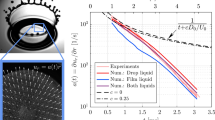Abstract
Results of a complete study of the rheological properties of highly concentrated emulsions of the w/o type with the content of the dispersed phase up to 96% are reported. The aqueous phase is a supersaturated solution of nitrates, where the water content does not exceed 20%. Dispersed droplets are characterized by a polyhedral shape and a broad size distribution. Highly concentrated emulsions exhibit the properties of rheopectic media. In steady-state regimes of shearing, these emulsions behave as viscoplastic materials with a clearly expressed yield stress. Highly concentrated emulsions are characterized by elasticity due to the compressed state of droplets. Shear storage modulus is constant in a wide range of frequencies that reflect solid-like behavior of such emulsions at small deformations. The storage (dynamic) modulus coincides with the elastic modulus measured in terms of the reversible deformations after the cessation of creep. Normal stresses appear in the shearing. In the low shear rate domain, normal stresses do not depend on shear rate, so that it can be assumed that they have nothing in common with normal stresses arising owing to the Weissenberg effect. These normal stresses can be attributed to Reynolds’ dilatancy (elastic dilatancy). Normal stresses sharply decrease beyond some threshold value of the shear rate and slightly increase only in a high shear rate domain. Observed anomalous flow curves and unusual changes of normal stresses with shear rate are explained by the two-step model of emulsion flow. Direct optical observations show that emulsions move by the mechanism of the rolling of larger droplets over smaller ones without noticeable changes of their shape at low shear rates, while strong distortions of the droplet shape is evident at high shear rates. The transition from one mechanism to the other is attributed to a certain critical value of the capillary number. The concentration dependence of the elastic modulus (as well as the yield stress) can be described by the Princen-Kiss model, but this model fails to predict the droplet size dependence of the elastic modulus. Numerous experiments demonstrated that the modulus and yield stress are proportional to the squared reciprocal size, while the Princen-Kiss model predicts their linear dependence on the reciprocal size. A new model based on dimensional arguments is proposed. This model correctly describes the influence of the main structural parameters on the rheological properties of highly concentrated emulsions. The boundaries of the domain of highly concentrated emulsions are estimated on the basis of the measurement of their elasticity and yield stress.
Similar content being viewed by others
References
Taylor, G.I., Proc. R. Soc. London, A, 1932, vol. 138, p. 41.
Pal, R., J. Rheol. (N. Y.), 2001, vol. 45, p. 509.
Pal, R., J. Colloid Interface Sci., 2003, vol. 263, p. 296.
Chanamai, R. and McClements, D.J., Colloids Surf., A, 2000, vol. 172, p. 79.
Jager-Lezer, N., Tranchant, J.F., Alard, C.V., et al., Rheol. Acta, 1998, vol. 37, p. 129.
Langenfeld, A., Schmitt, V., and Stébé, M.J., J. Colloid Interface Sci., 1999, vol. 218, p. 522.
Rocca, S. and Stébé, M.-J., J. Phys. Chem., B, 2000, vol. 104, p. 10490.
Ponton, A., Clément, P., and Grossiord, J.L., J. Rheol. (N. Y.), 2001, vol. 45, p. 521.
Babak, V.G., Lengfield, A., Fa, N., and Stébé, M.J., Prog. Colloid Polym. Sci., 2001, vol. 118, p. 216.
Mason, T.G., Bibette, J., and Weitz, D.A., Phys. Rev. Lett., 1995, vol. 75, p. 2051.
Mason, T.G., Bibette, J., and Weitz, D.A., J. Colloid Interface Sci., 1996, vol. 179, p. 439.
Derkach, S.R., Levachev, S.M., Kukushkina, A.N., et al., Kolloidn. Zh., 2006, no. 6, p. 769.
Princen, H.M., J. Colloid Interface Sci., 1983, vol. 91, p. 160.
Princen, H.M., J. Colloid Interface Sci., 1985, vol. 105, p. 150.
Princen, H.M. and Kiss, A.D., J. Colloid Interface Sci., 1986, vol. 112, p. 427.
Princen, H.M., J. Colloid Interface Sci., 1989, vol. 128, p. 176.
Lacasse, M.-D., Grest, G.S., Levine, D., et al., Phys. Rev. Lett., 1996, vol. 76, p. 3448.
Masalova, I., Malkin, A.Ya., Slatter, P., and Wilson, K., J. Non-Newtonian Fluid Mech., 2003, vol. 112, p. 101.
Malkin, A.Ya., Masalova, I., Slatter, P., and Wilson, K., Rheol. Acta, 2004, vol. 43, p. 584.
Masalova, I., Taylor, M., Kharatiyan, E., and Malkin, A.Ya., J. Rheol. (N. Y.), 2005, vol. 49, p. 839.
Malkin, A.Ya. and Masalova, I., in Advances in Rheology and Its Applications, Luo, Y., Rao, Q., and Xu, Y., Eds., New York: Scientific, 2005, p. 5.
Masalova, I., Malkin, A.Ya., Ferg, E., et al., J. Rheol. (N. Y.), 2006, vol. 50, p. 435.
Bampfield, H.A. and Cooper, J., in Encyclopedia of Emulsion Technology, New York-Basel: Marcel Dekker, 1985, vol. 7, p. 281.
Pal, R., Colloids Surf., A, 2000, vol. 162, p. 55.
Malkin, A.Ya. and Isayev, I., in Rheology. Conceptions, Methods and Applications, Toronto: ChemTec, 2006, chap. 3.
Pons, R., Erra, P., Solans, C., et al., J. Phys. Chem., 1992, vol. 97, p. 12320.
Pons, R., Solans, C., and Tadros, Th.F., Langmuir, 1995, vol. 11, p. 1996.
Lodge, A.S., Elastic Liquids, London-New York: Academic, 1964.
Reiner, M., in Handbuch Der Physik. Vol. 6. Elastizität und Plastizität, Berlin: Springer, 1958.
Malkin, A.Ya. and Masalova, I., J. Rheol. (N. Y.) (submitted).
Masalova, I. and Malkin, A.Ya., Appl. Rheol. (in press).
Author information
Authors and Affiliations
Additional information
This work was presented in part at the 4th Pacific Rim Rheological Conference (Shanghai, China, 2005) and the World Congress on Emulsions (Lyon, France, 2006)
Original Russian Text © I. Masalova, A.Ya. Malkin, 2007, published in Kolloidnyi Zhurnal, 2007, Vol. 69, No. 2, pp. 206–219.
Rights and permissions
About this article
Cite this article
Masalova, I., Malkin, A.Y. Peculiarities of rheological properties and flow of highly concentrated emulsions: The role of concentration and droplet size. Colloid J 69, 185–197 (2007). https://doi.org/10.1134/S1061933X0702007X
Received:
Issue Date:
DOI: https://doi.org/10.1134/S1061933X0702007X




